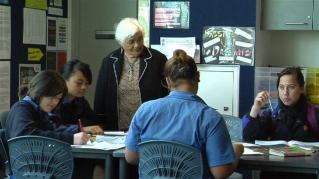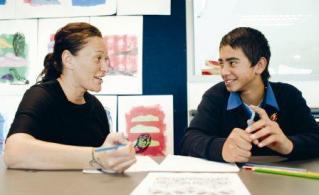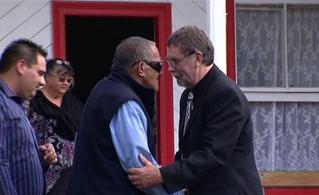Section navigation
Three schools in the Te Kauhua initiative – Hillmorton, Lincoln, and Hornby High Schools - opted to cluster together for purposes of their research inquiry. They worked from a common research question, but tailored their inquiries to their individual school contexts. The cluster schools met regularly over the duration of the project, sharing findings and challenging one another’s practice and thinking. The following case study, prepared for the Ministry of Education by Dr Ruth Gorinski as part of the Te Kauhua case studies report (2010), highlights the approaches and findings of Lincoln High School.
Background
Lincoln High School (LHS) is a decile nine, urban school located in the Christchurch area with a roll of 1425 students of which 10% identify as Māori, 82% Pakeha and the remaining 8% of mixed ethnicity. The school has been involved in the Te Kauhua initiative since 2007.
Research Question
How, as part of a cluster arrangement, can a school foster the development of an effective professional learning community that is focussed on teaching as inquiry and premised on three underpinning principles: ako (reciprocal learning), culture counts and productive partnerships?
Impetus for the initiative
Improving Māori student achievement outcomes is a Board of Trustees (BOT) strategic goal at LHS. The school’s methodology for realising this goal includes a co-opted iwi position on the BOT, active role modelling by the Principal, cultural leadership by the Assistant Principal and the utilisation of key Māori teachers as leaders, to alleviate overload on the Head of Te Reo. The BOTs strategic goal provided an impetus for the school wide inquiry.
What was done?
Staff formed cross curricular learning teams that had an inquiry based pedagogical focus e.g. involving students in their learning; co-operative learning; using technology to improve learning. Bishop’s Effective Teaching profile provided a framework for teachers to create culturally appropriate and responsive contexts for learning in their classrooms. A SOLO taxonomy was adopted as the whole school thinking skills model to guide the action research.
The aim for all teacher professional learning, was to help students achieve merit and excellence endorsements in NCEA. In addition to the teacher professional learning, the school consulted regularly with the rūnanga and this strengthened productive partnerships between the school and rūnanga.
Whānau –school interactions were also addressed as part of the LHS research focus. These changed from traditional one way information events to more interactive, whānau driven initiatives. Te Reo Maori has been made more visible across the school through bilingual signage, staff professional development in Te Reo, the implementation of school waiata and principal adoption of te reo in formal settings and email.
What was the impact on student learning and achievement?
In 2003, only 23% of Lincoln Māori students passed NCEA Level 1. By 2009 this had increased to 89%. Māori students are staying at school longer and gaining increasingly higher qualifications. This turnaround occurred because LHS took responsibility for the unacceptable results and genuinely committed themselves to changing the ways they serve Māori students and whānau. Through a process of deliberate, slow steps, based on research and whānau input, the outcomes for Māori students have dramatically increased.
Key learning
- Endorsement from the BOT, to the strategic goal of strengthening Māori student achievement outcomes is necessary for ongoing commitment and prioritisation of the goal.
- Principal commitment is a top priority in ensuring successful outcomes.
- Selecting the right people to lead the process is a critical success factor.
- To ensure ongoing action and impetus, a time allowance needs to be factored in to the leadership and facilitation of the strategy.
- Working closely with whānau and the rūnanga is paramount.
- Learning from and with a cluster of schools is invaluable.
- Regularly celebrating small successes encourages all involved.
- Listening to student voice is critical to ‘getting it right.’
- Working with classroom teachers to help them build a repertoire of teaching and learning strategies and characteristics that have been shown to increase Māori student achievement, ensures action.
- Be focused upon tikanga in the school while working towards biculturalism. Ensure that Māori knowledge is accepted as both relevant and important.
Challenges and opportunities
- Māori students are dispersed thinly across the school and so there is not a focused concentration of numbers to facilitate a sense of urgency for action.
- Ensuring that all staff and students recognise the importance and value of culture in their curriculum planning and delivery.
- Working with staff to help them understand that they unconsciously ‘teach who they are’. Consciousness brings choice and the ability to consider the world views of those from cultural backgrounds different to their own. This is an ongoing leadership challenge.
- Building strong mutual partnerships with whānau, rūnanga, and iwi. Ensuring that their voices are listened to and acted upon is critical to partnership building.
Reflective questions
- What schools in our area might we partner with to develop our capability and capacity to build a learning community that is focused on the principles of ako, culture counts and productive partnerships?
- How can we strengthen our relationships with local rūnanga?
- In what ways does our school reporting system support interactions that foster productive partnerships with whānau? How can we further strengthen this?
Filed under: Productive partnerships | Effective leaders | Effective teachers





